Starlink 2023, the ever-changing state of affairs
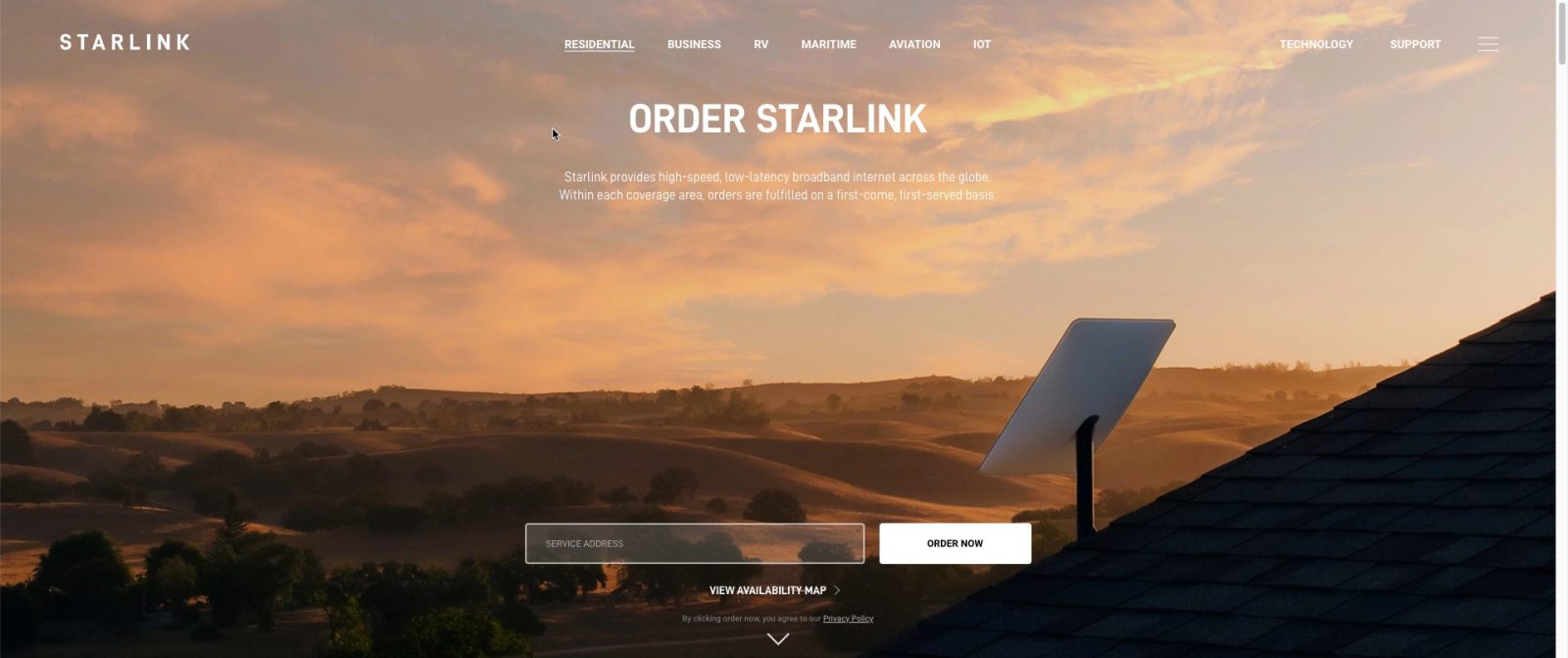
Starlink, like all Elon Musk-backed companies, seems to operate by a different set of rules than what we might expect. The rules change often, generally without notice, and sometimes in highly impactful ways. A recent series of announcements changed the rules, options, and pricing for subscribers. Especially for those who use Starlink on the move. So, what’s the current state of Starlink, and is it a good option for boaters? Read on, and I’ll try to break it down for you.

There have been several changes since I posted about Starlink in July of last year. The officially supported in-motion antenna represents the most significant change on the hardware front. We will talk more about that in a minute. Starlink service has seen several important changes: the addition of prioritized data caps, the elimination of portability on residential plans, and a price change raising the price of RV and residential in capacity-constrained areas and lowering the price in areas with excess capacity.
I’ll break down as many of the developments as I can. But Starlink doesn’t make it easy. Like the rest of Elon Musk’s companies, Starlink has no public relations department or function. They don’t make it easy to understand the options and rules. Plus, I’ve regularly encountered outdated and conflicting information in their policies and specifications.
Expectations and changes
It’s been two and a half years since Starlink announced its “Better than nothing” beta and started selling service. It’s also been a year and a half since the end of that beta, but changes continue to roll out like a service in beta. These changes have created confusion and some hurt feelings. Starlink groups on Facebook often read like the transcript of a therapy session. The best advice I can give is to realize that change is constant. Just because something works doesn’t mean you’re promised it will be tomorrow. This may be frustrating, but as consumers, our only real recourse is not to consume the service if we don’t like the terms.
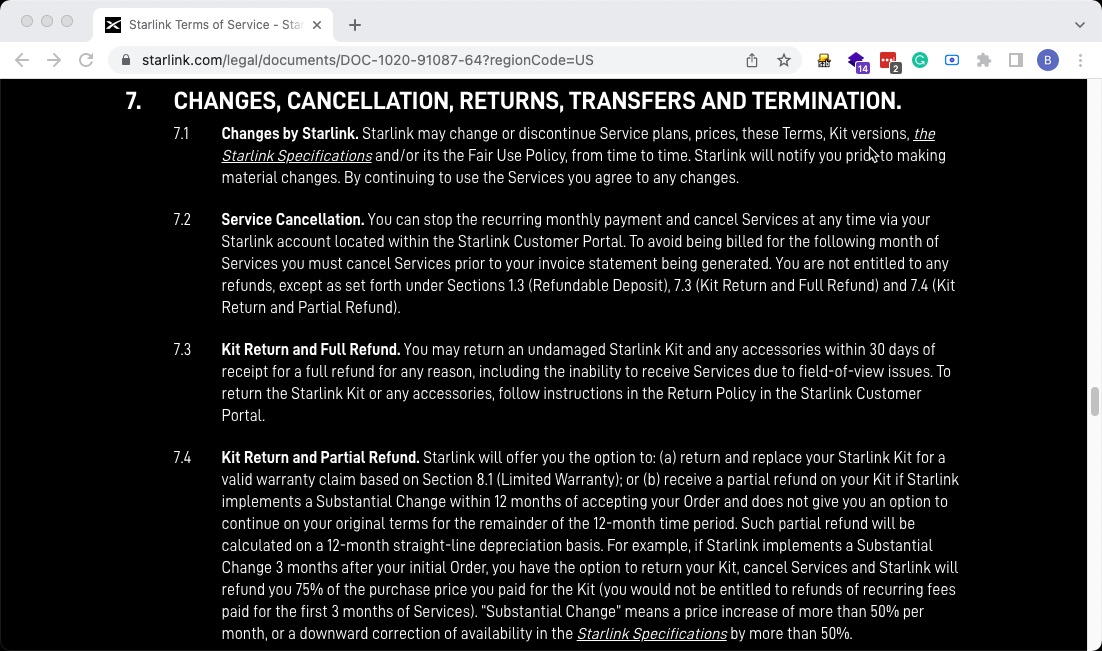
Starlink’s terms of service say users will be informed in advance of changes to the terms of service or the service itself. However, the most recent change, which includes the elimination of portability for residential subscribers and pricing changes, came with no advance notice.
Fundamentally, Starlink is going about the business of providing satellite internet connectivity in a novel manner. If we look at how other companies have tackled this, they’ve usually started with high prices and a small customer base. Over time, and as the network is proven, operators have expanded their customer base by lowering their pricing. Starlink has done just the opposite; they entered the market with $500 equipment and $100 per month service. Starlink has now raised prices twice and introduced tiered data caps. Let’s take a look at the state of affairs and what we know now.
Hardware options



By all appearances, Starlink is making two terminal types: the 513mm x 303mm, $600 standard terminal, and the $2,500 575mm x 511mm high-performance terminal. The standard terminal is only available with the attached mast, azimuth, and elevation motors. The high-performance terminal is available with the mast and azimuth and elevation motors or in a wedge-shaped, fixed configuration.
| Standard | High performance | High-performance, in motion | |
| Residential | X | ||
| Business | X | ||
| RV | X | ||
| RV in motion | X | ||
| Maritime | X – two antennas – $5,000 |
If I’ve correctly interpreted the options, the table above represents the matrix of hardware-to-service options. RV service is currently unique in that if you have the standard $600 equipment, the terms of service say it may not be used in motion. But, if you’ve purchased the $2,500 equipment, in-motion use is approved.
Rumors are circulating of a smaller terminal, described as the size of a laptop computer. But, there’s no timeframe on that and based on the lack of regulatory filings it seems reasonable to assume it’s not on the immediate horizon. Additionally, Starlink doesn’t offer any terminals that can be directly powered by DC. There are numerous DIY modifications to allow the hardware to run directly from DC, but at a minimum, those require cutting and splicing cables.
Service options
There are four service options available today: Residential, Business, RV, and Maritime. As shown in the matrix above, each service is paired with hardware. The outlier is RV service which can be used with either the standard dish or the high-performance dish. The difference
| Monthly Cost | Expected performance – down/up | Latency | Prioritized data | Portability | In motion | |
| Residential | $90 or $120 based on cell capacity | 20-100 / 5-15 Mbps | 25-50ms | |||
| Business | $500 | 40-220 Mbps / 8-25 Mbps | 25-50ms | |||
| RV | $150 | 5-50 / 2-10 Mbps | 25-50ms | X | X – with HP terminal | |
| Maritime | $5,000 | 60-250 / 10-30 Mbps??? | 25-50ms | X | X |
You may have noticed I’m not sure about the expected performance of Starlink’s $5,000 per month maritime plan. I don’t want to dwell on the maritime plan too much because I don’t think many Panbo readers are really in the target market of commercial shipping, oil platforms, and cruise ships, but let’s take a look at the performance specifications for a minute. They may hold some clues about the future:
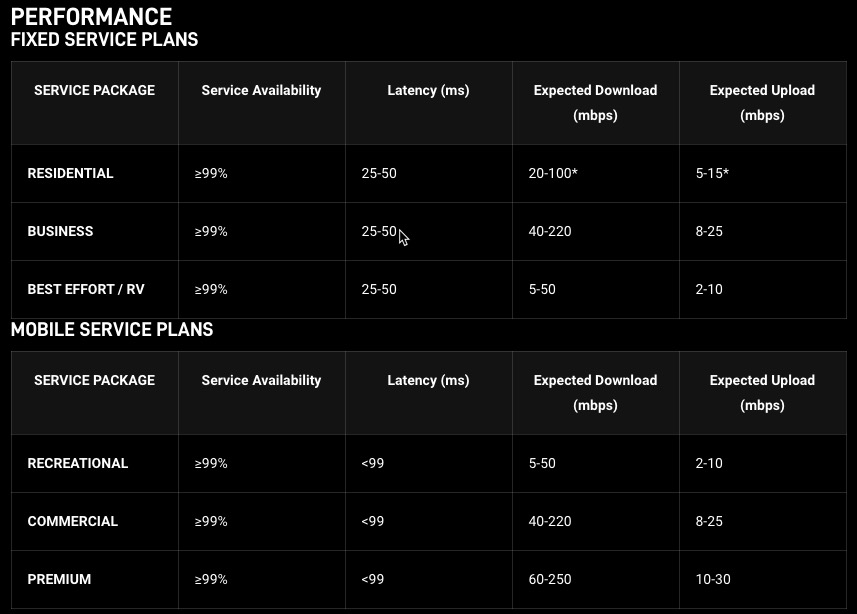
As you can see, the three fixed service plans match up well to Starlink’s existing service offerings. However, when we look at the mobile service plans specs, it’s tougher to match up. I’m guessing that recreational currently corresponds to RV in motion, but might it also apply to a future recreational marine offering? From there, I don’t have a guess about whether maritime is a commercial or premium mobile service plan. I thought the quoted “up to 350 Mbps” from the maritime product page might offer a hint, but that number also doesn’t match up to anything here.
Reseller maritime plans
Edit 3/7/23: Shortly after I initially published this article, a member of the Facebook group Starlink on Boats alerted me to the availability of additional maritime plans through resellers. I’ve reached out to one of those resellers to try and get more information on those plans and will update when I have more info. It seems there is an option for a $1,000, 1-terabyte plan, though it also appears that plan may require additional services at an additional cost from the reseller.
Service changes
As I mentioned at the top, there are three major changes to Starlink’s service options. Let’s take a look at all three:
Prioritized data caps
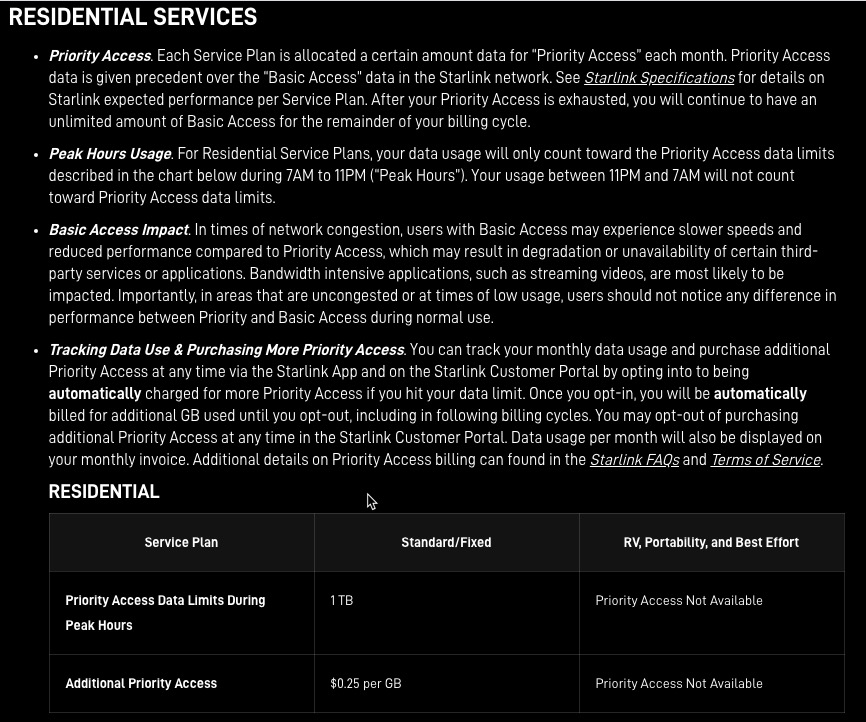
At the end of last year, Starlink introduced priority data caps. For residential service, priority access is limited to 1 terabyte of usage during peak hours, 7AM to 11PM at the service address. Usage outside of peak hours doesn’t count toward the limit. For residential service, once the allotment is exhausted, traffic is given what Starlink calls basic access and prioritized behind priority access traffic, but the speed isn’t limited. RV traffic is always handled as basic access, as is residential with portability when you’re away from your service address.
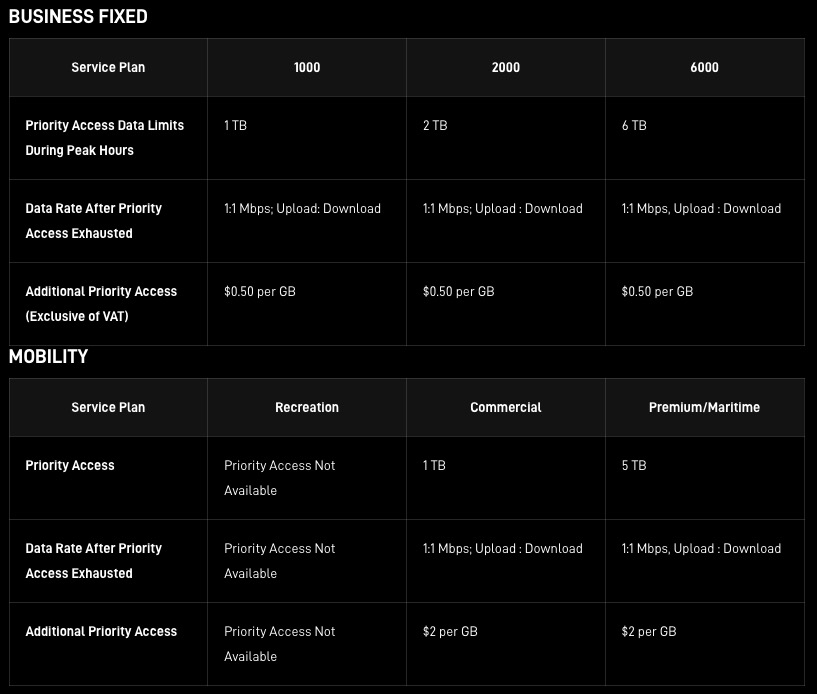
Residential traffic after the priority access cap and all RV traffic isn’t throttled or rate shaped; it’s just lower priority. Business and maritime traffic is throttled all the way down to 1 Mbps up and down. That’s pretty extreme and while sufficient for sending an email or browsing the web (slowly), it’s a huge step down from the throughput of priority access data. Maritime’s priority cap is set at five terabytes, a fairly large allotment but also a number more likely to be reached on a commercial vessel with multiple people using the connection. Oddly, this table is the only place that I’ve found the tiering of business plans, so I’m unclear what cap applies to the $500 per month business plan.
Price changes
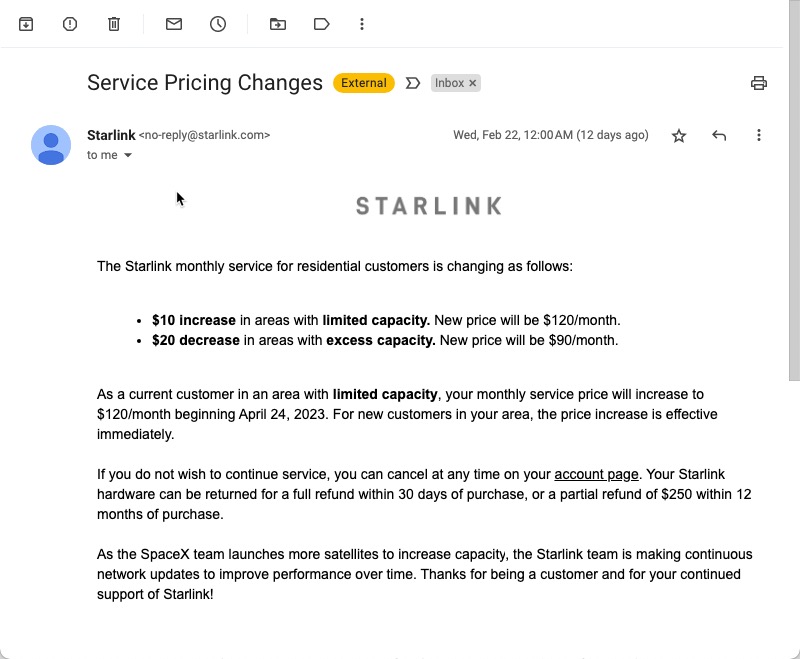
For the second time since turning on their network, Starlink has changed the pricing of their service in the United States. They’ve experimented with their pricing in other countries pretty frequently but have seemingly been more cautious with the U.S. pricing. First, less than a year after launching the price of residential service went from $99 to $110 a month. Now, effective immediately for new customers and in April for existing customers, the price will increase to $120 for customers in areas with limited capacity. In a first for Starlink in the U.S., they’re reducing the service price in areas with excess capacity. Customers in those areas will now pay $90, $20 less than they were paying previously. Subscribers to the RV plan will see their service price increase from $135 to $150.
It’s unclear how often areas might be changed from excess capacity to limited or vice-versa. I’m also not clear if a user with portability could move their service address to an area with excess capacity and enjoy a $30 discount.
No more portability
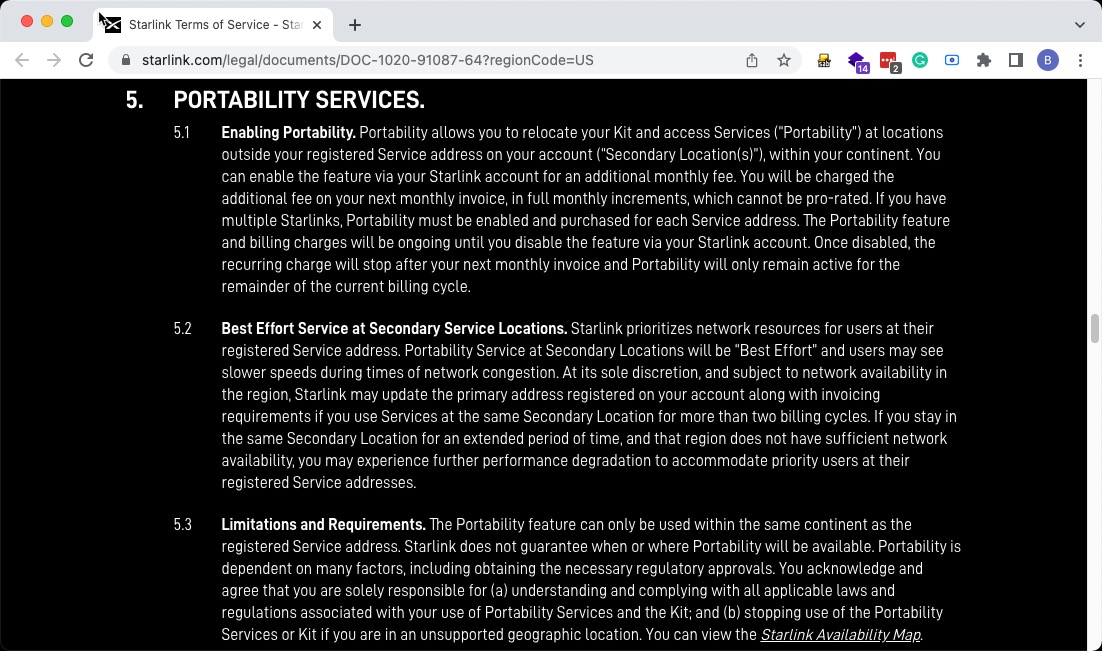
Although not announced and still not cleaned up in their terms of service, Starlink also removed the ability to add portability to residential service accounts in the United States. It appears customers with portability turned on will be able to keep it. But, if a subscriber removes portability, they won’t be able to re-add it. This change caught many customers off guard and seems to run counter to Starlink’s own commitment to notify subscribers before changes.
Mounting options

Starlink uses proprietary cables and a custom mounting solution for their products. Because of these proprietary pieces, it’s taken a while for better mounting options to become available. My preferred solution to mounting Starlink is the 1-inch 14 adapters you see above. These adapters are made by E-Riggers and sell for $85.00. They attach to a standard VHF antenna mount. I’ve used both a ratcheting mount like on the right as well as a simple flange mount like on the left. It’s been my experience that with properly sized hardware this is as sturdy a mounting option as you’re going to find.
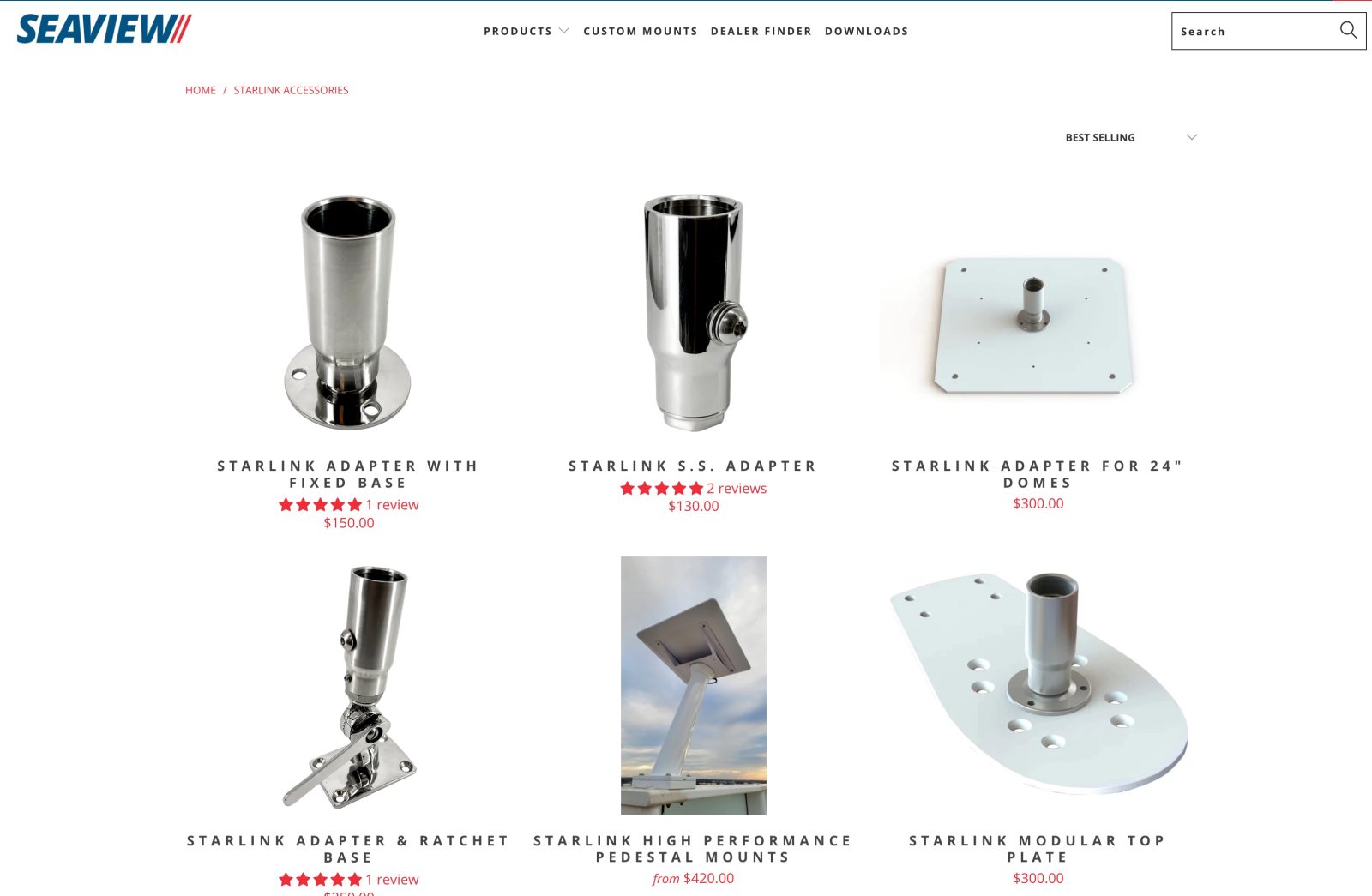
If you’re looking for other mounting options, including reusing a mounting location from a satellite dome, SeaView has a range of mounting options. Their mount for the wedge-shaped in-motion terminal caught my eye, as I haven’t seen many options for that receiver yet.
How far we’ve come
I think there’s cause for frustration with some of how Starlink has managed change. I certainly wish there was someone I could contact to find answers to my questions. But I’m also aware of the bargain Starlink represents.
This summer, my family is planning a two-plus month road trip in our RV. We will explore much of the south, west, and mid-west. Along the way we plan to visit many local, state, and national parks. Often, these are places with little or no internet connectivity. But, with Starlink, I know that as long as I can find a clear view of the sky, I’ll have connectivity. Is that worth roughly $150 a month to me? You bet!

My terminal sits in the yard beside my RV when we aren’t traveling. Keeping it set up means it is receiving firmware updates as they become available. I’ve read a few accounts of people who’s equipment wasn’t receiving updates and eventually got too far behind to be updated. Starlink told them they’d need new equipment. While this explanation strained my understanding, it seems like cheap insurance to leave the unit powered on and receiving updates.
In a recent comment on another post, Ben Ellison said, “…I see some informed people quite doubtful the future StarLink will be nearly as great a deal on boats as it has been at first.” I fear there’s wisdom in what he says.
I think it’s safe to say Starlink is experimenting with its service offerings, pricing, and policies. As boaters, we have benefited from some of those experiments. But will it last? I certainly don’t think everything we’ve experienced thus far will. Anecdotal reports I hear suggest there are almost no geographic restrictions in place on the network right now. RV service works in open oceans, North American accounts work in Europe, and more. But I fully expect that will change. I am hopeful Starlink will offer open ocean coverage to recreational cruisers at a price more affordable than the current maritime package. However, I think it’s safe to assume it won’t come for the $ 150-a-month RV service commands either.
Final thoughts
Starlink is a bargain. I often read complaints from people comparing the cost of Starlink to the cost of cable, fiber, or cellular internet. Compared to those options, Starlink can appear expensive. But, my goodness, this is internet from outer space for $150 a month. None of those other options will work in the vast stretches of nothingness in which Starlink shines. I remain hopeful that OneWeb or another low-earth orbit satellite constellation will provide Starlink with competition, but launching a constellation of satellites is extremely difficult and expensive. So, for now we may need to be content with the options Starlink provides.













SeaView even has a StarLink adapter for empty user-supplied 24-inch KVH or Intellian domes, and I guess that situation could apply to sat coms or sat TV. Ouch!
Looks like I published this article just a day too early. Today, Starlink has renamed the RV service to Roam. I think that’s a great idea for clarity. Thus far, I don’t see any other differences but a more careful examination is in order.
-Ben S.
A more careful review shows you can now select continental roaming ($150/month) or global roaming ($200) but the text on the ordering page clearly states its for land use. So, it looks like there’s still a gap in the offerings for recreational boaters. For now, Roam is the best fit, but hope remains we will see an open oceans recreational offering.
-Ben S.
One more comment from reading the terms and conditions more closely. I don’t previously recall seeing such a clear call out of use on land:
“Starlink Roaming “Regional” Plan allows you to access Services at any land-based destination…”
-Ben S.
Right, plus “Starlink Roam is for land use only.” as the first sentence of the Roam order page. Hard to get more prominent than that.
But do you think it’s safe to presume that Roam service portable StarLinks will keep working in the places we typically anchor or moor?
I’d guess that the StarLink built-in GPS is capable of very tight geofencing but doubt that they’d restrict use to less than, say, a mile from land, islands included. (There are now a lot of Starlinks on Maine island, incidentally.)
Am I just being overly optimistic, again?
My feeling (and it’s nothing more than MY feeling) is that Starlink has to error on the side of allowing a little bit of near-shore usage. If they try and get too fine with their geo-fencing, they’re likely to snare some land users in the fence occasionally. I suspect they will set the geofence borders a mile or two off shore. I suspect that will serve their needs of making a (hypothetical) future recreational marine product still clearly differentiated, but avoid excessive support tickets stemming from a waterfront location.
-Ben S.
It may be worth considering (and/or researching) the possibility that Roam is “restricted to land-use only” as a Starlink CYA for premature lat/long motor failure trying to keep up with the pitch/roll of a boat at anchor or underway. Just a thought I had thinking about the environmental factors of a boat at sea vs even an RV unit “improperly” used while underway on land. Like most Starlink “loopholes,” it might take someone trying it out till it doesn’t work anymore to find the answer!
Technically they could geofence very tightly, as the dish has GNSS receiver I presume and database on what is land and what is not is accurate to few feet / meters.
Good if they choose not to.
Consider Viasat as an option. The cost is competitive with “normal” internet usage per month and works great in rural areas with the same site restrictions as Starlink. Plus Viasat because of competition has maintained their price but doubled their monthly usage pricing
Viasat is nowhere near the performance of Starlink. I’ve had both. Viasat’s customer service is garbage. Their latency is in excess of 650msec, and their data allowances are ridiculously small. Furthermore, they throttle video bitrate. Starlink is an order of magnitude better than Viasat
Wow, I just went and looked at Viasat’s plans. While the plans are better than the last time I looked at them (a long time ago), I still don’t think they’re very competitive. A plan that delivers half the data of Starlink, 500 gb, at a maximum speed of 30 Mbps is $199.99 / month for the first three months, but then it jumps to $299.99. I’ve got to say, that’s pretty annoying stuff with the promotional price in bold and the actual price in the fine print.
I’m not sure if Viasat would work in any sort of mobile application. But, based on their requirement for professional installation and a 30-inch by 28-inch dish, I think the only comparison that would make sense is to Starlink’s residential service. Starlink is going to deliver twice the priority data at 3-6 times the throughput and one-tenth the latency. That all adds up to a tough comparison for Viasat.
-Ben S.
Had starlink since 2021/2022. Prior to that had XploreNet which was crap. No other competitors exist right now as it’s time consuming and expensive to replicate what Starlink did.
Yes, they’re considerable confusion over the pricing for example Europe is €100 per month in Australia $50 a month
Thanks for what you do Ben. Very informative, and Johnny on the spot with the last minute changes from RV to Roam. Think I will continue to sit on the sideline and wait for more clarity.
For those who work and need access, it’s pretty clear that Starlink is very useful. But for those heading off into the blue, please give some thought before you jump on the 24/7 bandwagon. There is a world that people are forgetting that is not tied to news and social media. In the past, it was an important reason people went to sea — to follow a different path.
More about that here: https://www.cruisingworld.com/people/making-a-case-to-disconnect/
It’s important to make conscious decisions.
Fair winds,
Bruce
I love to watch starlink satellites for a few days after launch. Magical view
Here’s a good way to see where the strings are over earth as they slowly deploy to their 540 km altitude and planned orbit:
https://satellitemap.space/
Evidence is building that StarLink is tightening up on Terms of Service limitations like no use underway without an actual $2,500 in-motion antenna:
https://loosecannon.substack.com/p/reality-check-for-starlink-boaters
Some commenters on FaceBook Starlink for Boats are claiming it’s a scam, but others say that the portable SL antennas cause interference to other satellite coms when used in motion:
https://www.facebook.com/groups/starlinkonboats/posts/1288081648410504/
Gotta wonder if they’ll next tighten up on “Starlink Roam is for land use only” and what that will mean near shore.
It does indeed appear that Starlink is following the same playbook they’ve used previously. That is, to create demand for a new option by enforcing previously unenforced portions of the terms of service (TOS). In this case, the signs aren’t lining up perfectly, but I think a new, more affordable maritime option might be part of the reason for TOS enforcement.
I’ll put together a post detailing the changes and breaking down what $250 a month now gets you.
-Ben S.
It is a real concern that SL causes interference to GEO sats. Thats the reason small dish needs to tilt _away_ from the GEO belt.
If SpaceX does not take it seriously, then the relevant authorities will
How far offshore will the service work since I believe the satellites needs to see the ground station and the vessel at the same time??
Hi Ben!
Johnny,
Starlink uses laser inter-satellite links (ISL) to connect satellites to link satellites that can’t directly reach a ground station. Thus, they can provide coverage in open oceans hundreds or thousands of miles from land.
-Ben S
I received this yesterday. It seems to confirm what has been talked about, above. I probably received this because we used Starlink in the Abacos Islands and in motion from North Palm Beach there and back.
“ [Action Required] Update your service plan
Over the past 60 days, your Starlink has been used in areas that violate the terms and conditions of your service plan: your plan does not include service on the ocean. Starting as early as May 9th, 2023, you will be unable to connect to the internet on the ocean except to access your Starlink account where you can make updates to your account.
To ensure uninterrupted service on the ocean, please take action before May 9th, 2023. The following options may be a good fit for you:
Change Service Plan to “Mobile Priority – 50GB/1TB/5TB”: Plans with Mobile Priority data enable our fastest network speeds and can be used on the ocean and land, and in motion with the Flat High Performance Starlink. After using the included Mobile Priority data, you will continue to have unlimited Mobile service on inland coverage (including lakes and rivers) anywhere Starlink has service around the world. Additional Mobile Priority Data (with service on the ocean) can be purchased by the GB.
Opt-in to Mobile Priority Data per GB: Opt-in to purchase Mobile Priority Data by the GB, if you are on a Mobile plan (“Roam”). This is a metered option – all data consumed when opted-in will be charged on your next monthly bill. You can opt-out at any time.
How do I opt-in to additional data or change my service plan?
On your account page online, click “Manage” under “Your Starlinks”, then select the “Mobile Priority” toggle or click “Change Service Plans”.
On your account page on the App, click “Data Usage”, then select the “Mobile Priority” toggle or click “Manage Subscription”.
You can read our updated Terms of Service for more details on our Mobile and Mobile Priority service plans. Please contact Support if you have additional questions.”